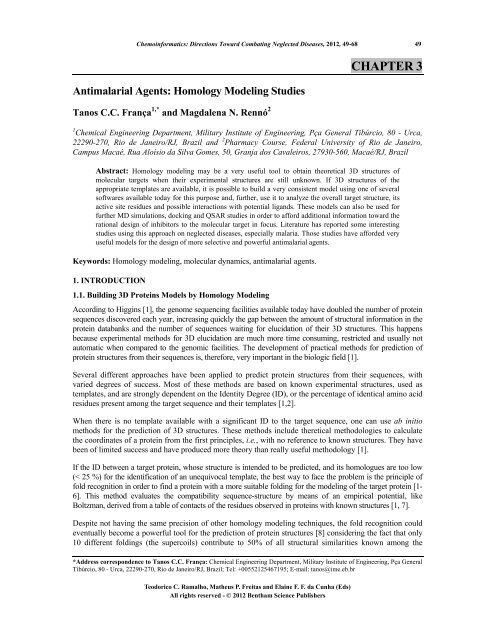chapter 1 - Bentham Science
chapter 1 - Bentham Science
chapter 1 - Bentham Science
You also want an ePaper? Increase the reach of your titles
YUMPU automatically turns print PDFs into web optimized ePapers that Google loves.
Chemoinformatics: Directions Toward Combating Neglected Diseases, 2012, 49-68 49<br />
Antimalarial Agents: Homology Modeling Studies<br />
Tanos C.C. França 1,* and Magdalena N. Rennó 2<br />
Teodorico C. Ramalho, Matheus P. Freitas and Elaine F. F. da Cunha (Eds)<br />
All rights reserved - © 2012 <strong>Bentham</strong> <strong>Science</strong> Publishers<br />
CHAPTER 3<br />
1 Chemical Engineering Department, Military Institute of Engineering, Pça General Tibúrcio, 80 - Urca,<br />
22290-270, Rio de Janeiro/RJ, Brazil and 2 Pharmacy Course, Federal University of Rio de Janeiro,<br />
Campus Macaé, Rua Aloísio da Silva Gomes, 50, Granja dos Cavaleiros, 27930-560, Macaé/RJ, Brazil<br />
Abstract: Homology modeling may be a very useful tool to obtain theoretical 3D structures of<br />
molecular targets when their experimental structures are still unknown. If 3D structures of the<br />
appropriate templates are available, it is possible to build a very consistent model using one of several<br />
softwares available today for this purpose and, further, use it to analyze the overall target structure, its<br />
active site residues and possible interactions with potential ligands. These models can also be used for<br />
further MD simulations, docking and QSAR studies in order to afford additional information toward the<br />
rational design of inhibitors to the molecular target in focus. Literature has reported some interesting<br />
studies using this approach on neglected diseases, especially malaria. Those studies have afforded very<br />
useful models for the design of more selective and powerful antimalarial agents.<br />
Keywords: Homology modeling, molecular dynamics, antimalarial agents.<br />
1. INTRODUCTION<br />
1.1. Building 3D Proteins Models by Homology Modeling<br />
According to Higgins [1], the genome sequencing facilities available today have doubled the number of protein<br />
sequences discovered each year, increasing quickly the gap between the amount of structural information in the<br />
protein databanks and the number of sequences waiting for elucidation of their 3D structures. This happens<br />
because experimental methods for 3D elucidation are much more time consuming, restricted and usually not<br />
automatic when compared to the genomic facilities. The development of practical methods for prediction of<br />
protein structures from their sequences is, therefore, very important in the biologic field [1].<br />
Several different approaches have been applied to predict protein structures from their sequences, with<br />
varied degrees of success. Most of these methods are based on known experimental structures, used as<br />
templates, and are strongly dependent on the Identity Degree (ID), or the percentage of identical amino acid<br />
residues present among the target sequence and their templates [1,2].<br />
When there is no template available with a significant ID to the target sequence, one can use ab initio<br />
methods for the prediction of 3D structures. These methods include theretical methodologies to calculate<br />
the coordinates of a protein from the first principles, i.e., with no reference to known structures. They have<br />
been of limited success and have produced more theory than really useful methodology [1].<br />
If the ID between a target protein, whose structure is intended to be predicted, and its homologues are too low<br />
(< 25 %) for the identification of an unequivocal template, the best way to face the problem is the principle of<br />
fold recognition in order to find a protein with a more suitable folding for the modeling of the target protein [1-<br />
6]. This method evaluates the compatibility sequence-structure by means of an empirical potential, like<br />
Boltzman, derived from a table of contacts of the residues observed in proteins with known structures [1, 7].<br />
Despite not having the same precision of other homology modeling techniques, the fold recognition could<br />
eventually become a powerful tool for the prediction of protein structures [8] considering the fact that only<br />
10 different foldings (the supercoils) contribute to 50% of all structural similarities known among the<br />
*Address correspondence to Tanos C.C. França: Chemical Engineering Department, Military Institute of Engineering, Pça General<br />
Tibúrcio, 80 - Urca, 22290-270, Rio de Janeiro/RJ, Brazil; Tel: +00552125467195; E-mail: tanos@ime.eb.br

















